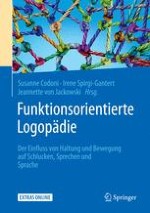Zusammenfassung
Der konventionelle therapeutische Umgang mit einer Dysfunktion des Körperabschnitts Kopf (HWS-Kopf) setzt den Schwerpunkt auf die Analyse der lokalen Pathomechanismen und berücksichtigt dabei kaum den Beitrag des faszialen Gewebes. Dieses Kapitel erläutert die aktuellen Erkenntnisse über das fasziale System. Die Beschreibung der anatomischen Gegebenheiten sowie der biomechanischen Eigenschaften des Fasziensystems begründet den Paradigmenwechsel von der isolierten Betrachtung der Muskulatur zu einer globalen myofaszialen Einheit. Das Wissen um die Interaktion der beitragenden Faktoren und deren Einfluss auf die Funktionsweise der Faszien als verbindende Struktur demonstriert die Notwendigkeit der globalen Betrachtung. Die Kontinuität innerhalb der oberflächlichen dorsalen myofaszialen Kette erklärt die funktionelle Interaktion am Beispiel der Körpersegmente Kopf und Füße. Die Funktion steht im Vordergrund des klinischen Denkprozesses und des therapeutischen Handelns.















